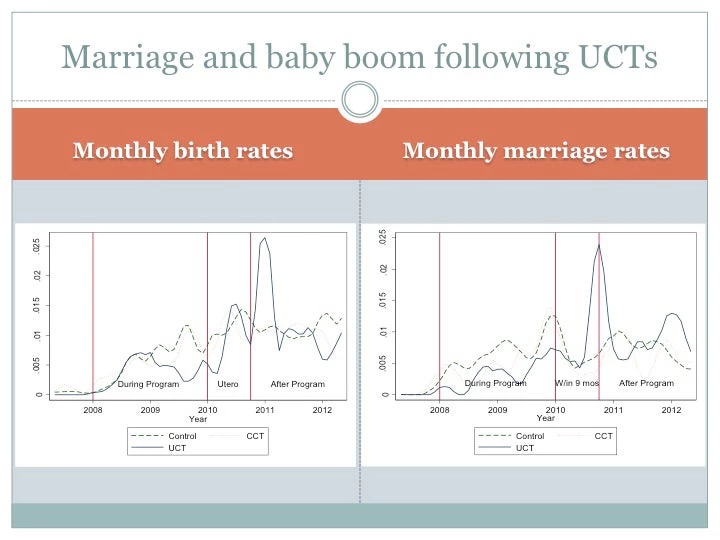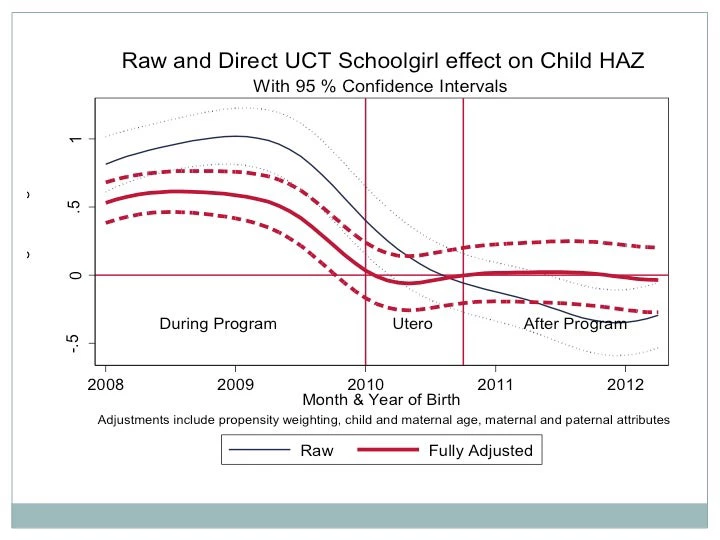Cash transfers are great – lots of people are telling you that on a continuous basis. However, it is an open question as to whether such programs can improve the wellbeing of their beneficiaries well after the cessation of support. As cash transfer programs continue to grow as major vehicles for social protection, it is increasingly important to understand if these programs break the cycle of intergenerational poverty, or whether the benefits simply evaporate when the money runs out…
The extant evidence on this question is growing, albeit still scant, and it is not particularly promising. For example, a recent paper by Araujo, Bosch, and Schady (2016), evaluating the 10-year effects of Ecuador’s Bono de Desarollo Humano cash transfer program, concludes that “…any effect of cash transfers on the inter-generational transmission of poverty in Ecuador is likely to be modest.”
In a recent paper, co-authored with Sarah Baird and Craig McIntosh, we report the effects of a cash-transfer experiment in Malawi more than two years after it ended, tracking a broad range of outcomes for females aged 18-27. Our earlier work has demonstrated the short-term effectiveness of cash transfers in improving school participation and test scores as well as reducing the incidence of pregnancy, marriage, psychological distress, and sexually transmitted infections during adolescence, indicating the possibility of finding longer-term improvements in well-being as young adults (Baird, McIntosh and Özler 2011; Baird et al. 2012; Baird, De Hoop and Özler 2013). In the new paper, following a pre-analysis plan, we first examine human capital accumulation, marriage and fertility, labor market outcomes, and empowerment among the beneficiaries to assess the persistence of the short-term effects. Then, as the majority of the study participants were married and/or had children at the latest follow-up, we examine their marriage market outcomes and their children’s physical development using data we collected on their husbands and anthropometric measurements of their children.
Here is a summary of our findings, which cannot possibly do justice to the paper, aided by some interesting figures:
- The short-term improvements in the UCT arm observed during the program failed to translate into increased welfare in the longer-run. Substantial reductions in teen marriages, total live births, and HIV infections, as well as improvements in psychological wellbeing and nutritional intake observed at the end of the program, were no longer apparent two years after the end of the intervention.
- Worse, in this group, the end of the cash transfer program was immediately followed by a marriage and baby boom among the beneficiaries, who reported lower levels of empowerment and had husbands with lower cognitive ability compared with both the CCT and the control groups. Notice that the large “baby boom” apparent in the UCT group 10-12 months after the end of the cash transfer program, indicating a spike in pregnancies immediately after the cessation of financial support, is preceded by a similarly-sized “marriage boom” only a few months earlier.

- However, there is some good news: consistent with improved physical and mental health during the program, we find evidence of improved height-for-age z-scores (HAZ) among children born to UCT beneficiaries during the program. Such effects are not present for babies born after the UCT program ended, even if they were in utero during the program.

- CCTs, on the other hand, caused sustained effects on school attainment, incidence of marriage and pregnancy, age at first birth, total number of births, and desired fertility – but only among the pre-specified stratum of adolescent females who had already dropped out of school at baseline: CCTs were highly effective in allowing a very large share of this group to return to school.
- In contrast with the marital outcomes in the UCT group, the increased educational attainment in this group was accompanied by assortative matching: their husbands were significantly more likely to have completed secondary school.
- However, even in this group, we find no gains in other important outcomes, such as individual earnings, per capita household consumption, subjective wellbeing, health, or empowerment. Among those who were in school at baseline, CCTs did not have any lasting effects, positive or negative, likely because the transfers were mostly inframarginal with respect to school attainment: 88% of the control group in this stratum completed primary school two years after the end of the program.
- Fleeting effects of UCTs: Only two years after the end of the program, UCT beneficiaries are, in most respects, in a position indistinguishable from where they would have been in the absence of cash transfers. Palliative benefits of small and frequent unconditional cash transfers are uncontested and reinforced by our study, but the idea that they can contribute to a sustained improvement in welfare over the longer-run is unproven and not supported in our data.
- Tradeoffs from imposing conditions: We also shed further light on the tradeoffs between the benefits of CCTs and UCTs. The lack of knock-on effects on welfare from significant schooling gains among baseline dropouts in this context implies that the imperative to use conditions to generate increased investments in formal schooling may not be the best idea when few income-generating opportunities exist.
- CCTs and (not or) UCTs: Moreover, by denying adolescent girls and young women cash transfers precisely when they are start childbearing, schooling CCTs may undermine one potential lasting effect of UCT programs during adolescence. One way of resolving this tradeoff is to view CCT and UCT programs as complements to each other rather than alternatives: policymakers could provide a basic unconditional cash transfer to adolescent girls topped up by conditional cash transfers for human capital accumulation and desired health behaviors – providing both an incentive to invest in education and health while still guaranteeing a basic level of protection to those who are unable or unwilling to comply with the conditions.
- Cash transfers for females of childbearing age: The promising (if only suggestive) evidence of the positive effect of UCTs on children’s height provides an additional reason to consider providing basic UCTs to adolescent females. Indeed, Currie and Almond (2011) have suggested that targeting transfers towards women of childbearing age may be beneficial in the U.S. context, so as to maximize benefits to children in utero. This form of targeting would suffer from remarkably little ‘leakage’ in the Malawian context; two thirds of women aged 20-24 gave birth by age 20 and virtually all females have started childbearing by age 25 (National Statistical Office and ICF Macro 2005).


Join the Conversation